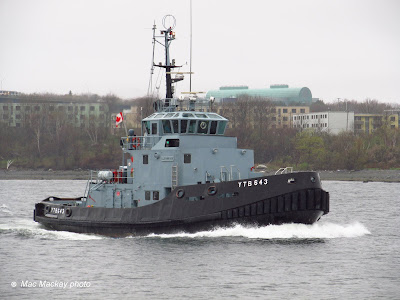An interesting tug and barge operation took place in the Minas Basin of the Bay of Fundy May 4 and 5. It involved the relocation of an old church from Walton, NS to Newport, NS. Because of its size and height the church could not be moved overland (it would involve too many interruptions to power and telephone lines) and so house mover Phil Leil masterminded the move by barge.
Although the operation was planned for last fall, weather did not cooperate, and so the move was delayed until this week when tides and winds were more cooperative.
The church was raised and loaded aboard a heavy truck trailer and driven aboard a former ferry barge. The barge is equipped with bow and stern loading ramps, and can drive up onto the beach to load and unload. Named
Fundy Trail, the 22m barge was recently retired from ferry service at Deer Island, NB. It is still owned by East Coast Ferries Ltd of Lord’s Cove.
To handle the barge East Coast’s two tugs
Fundy Trail II and
Hopper II were lashed on, one to each side and hauled the barge round from Walton to a position off Hantsport. They stood by there for the night and brought the barge in alongside the Newport wharf on Thursday May 5.
Firmly beached, with the tugs holding it in position, the barge lowered its ramps and the truck and trailer drove off.
Both tugs were built by East Coast Ferries.
Fundy Trail II in 2005. It is a twin screw vessel of 450 bhp.
Island Hopper II , built in 1999 is also twin screw, with 700 bhp. Built along the lines of southern US inland tugs, they are fitted with elevated wheelhouses to see over the barge deck.
There are several net references to this move:
Good still photos:
http://www.hantsjournal.ca/News/2011-05-05/article-2482193/Hitching-a-ride-home/1http://www.thestar.com/news/canada/article/986313--people-line-nova-scotia-river-to-watch-church-float-pastThen there is this breathless video account: http://www.cbc.ca/news/canada/nova-scotia/story/2011/05/04/ns-walton-church-floats.html
 1. Atlantic Condor returns to pier 9B this afternoon following day long trials in Bedford Basin.
1. Atlantic Condor returns to pier 9B this afternoon following day long trials in Bedford Basin.









 3. André H. shown in Trois-Rivières, has been based in Sept-Iles for the last two years.
3. André H. shown in Trois-Rivières, has been based in Sept-Iles for the last two years.









